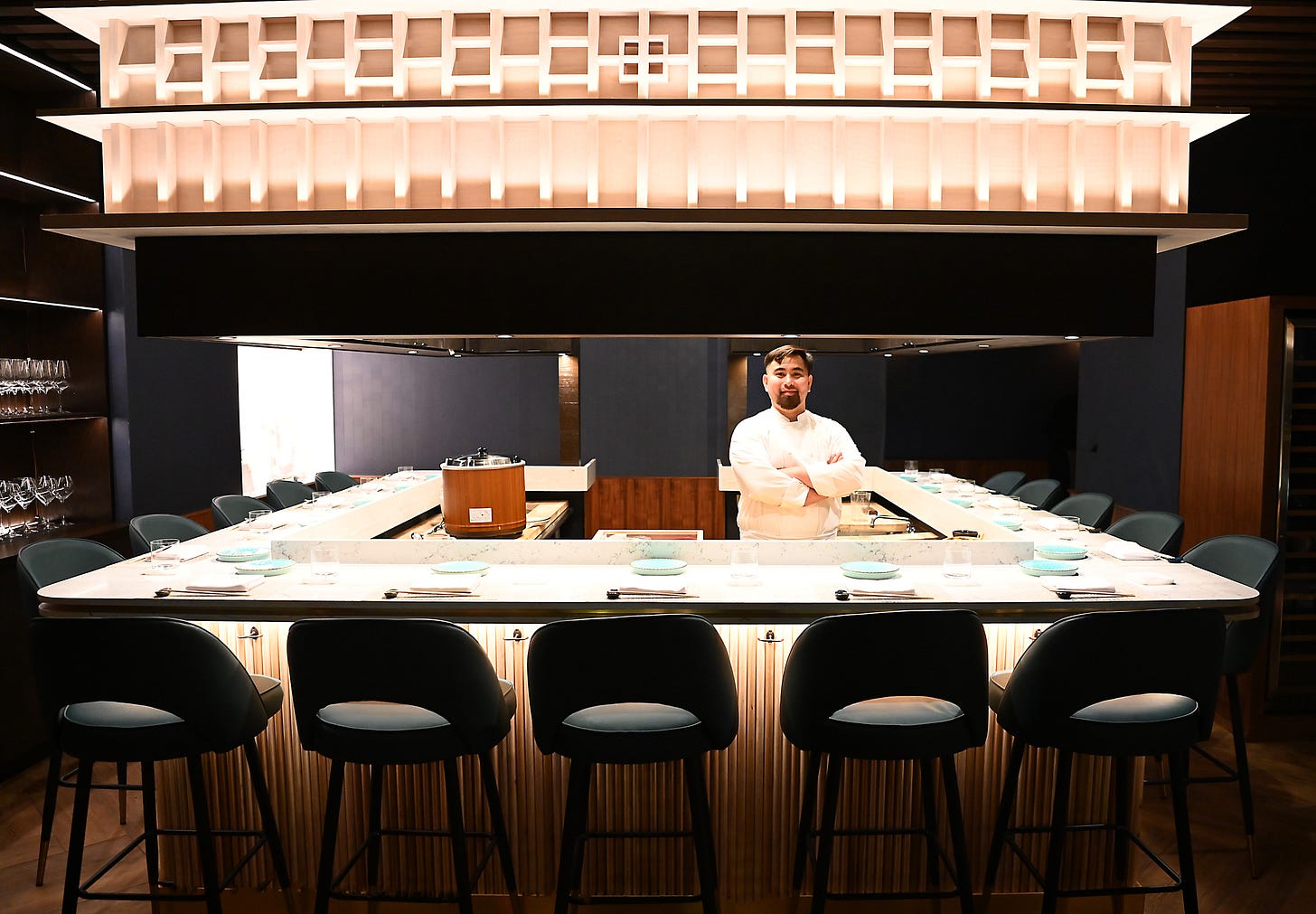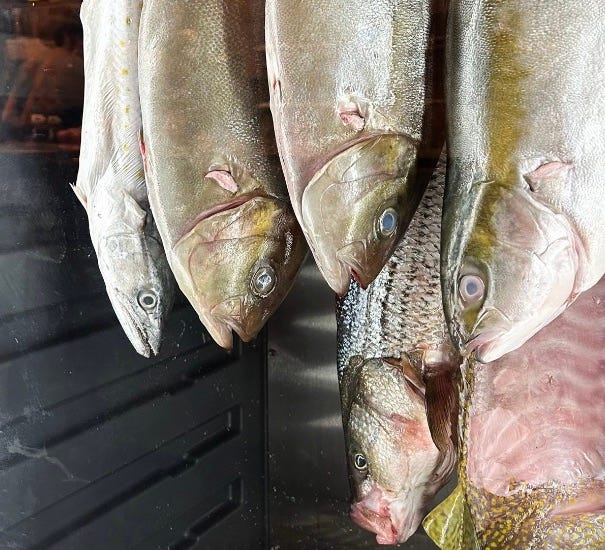How old is your fish? These chefs want it to age.
A century's-old Japanese technique crosses over at Mishik, Theodora, and Il Totano.
The other night at Mishik, the new Edomae-style sushi restaurant in the far reaches of the West Village, I was chatting with chef Markee Manaloto as he assembled little snacks for us, well actually beautiful pieces of nigiri, but you know, snacks really. (I mean sometimes you finish an omakase menu and you need a burger. Right? Or is that just me?)
Anyway, there were dozens of pieces of glistening fish coming my way: goldeneye snapper (kinmedai), black throat sea perch (nodoguro), rockfish (kinki), tuna, and sea urchin. The fish was excellent: what you dream of when you dream of sushi: buttery, supple, silky, and the flavor of each glossy rectangle was concentrated, big, and bold, achieved with little more than a brush of soy.
As I chatted with the chef, he told me about his fish. I’d assumed he would tell me it had been sourced by a secret group of trusted vendors from Tokyo’s Toyosu Market, then flown in that morning, arriving after a First Class journey with the Criterion Channel and complimentary Champagne. But I was wrong, well sort of. He does get his fish from a collection of skilled fisherman at the Toyosu Market, folks he’s known since his days as Omakase Chef at both Michelin-starred Sushi Yasuda and Kissaki, and as co-chef/partner at Japanese-Filipino izakaya Gugu Room.
But the thing I got wrong was the timing. The fish had not arrived that morning, nor the day before. Not even the week before. That’s because Manaloto doesn’t serve fresh fish. He seemed horrified by the idea. “Fresh fish is so boring,” he told me. Manaloto can’t stand it. His fish is aged, often for weeks.
It’s a process he learned in 2018 when he was working in Detroit, opening Pursue with artist Mike Han, where they focused on sustainable fish and were part of the James Beard Smart Catch program. Now, some years later, he’s refined his technique and dry-ages his fish in house.
The process of dry-aging fish, removing moisture to amplify flavor, would seem to make sense; beef is dry-aged for months to allow water to evaporate, fibers to break down, tenderizing the beef and intensifying its flavor.
Turns out that a little age does the same thing for fish. “During dry-aging, enzymes are breaking down the fish to create a tender texture and more concentrated flavor,” Manaloto told me. “The final product has a cleaner, more developed flavor and a firmer, more pleasing texture.” Correct.
Now, the dry-aging process isn’t something that’s done without thought. It’s not like the fish comes in and he tosses it in the cooler and comes back in a month, and voila, dry-aged deliciousness. Nope.
And before you start thinking about letting your Trader Joe’s salmon sit past its expiration date, think again. This process is not suited for farmed fish, only wild caught fish that is impeccably sourced. And if the seafood isn’t handled properly from the start, then it’s not a good candidate for dry-aging because it will end up tasting fishy. So for now, until the makers of the Air Fryer create a The Fish Ager, leave it to the experts.
At Mishik, the process starts the moment the fish arrives. First, the fish gets inspected, to see how well it was harvested — preferably the ike jime process, where the fish is killed instantly so it doesn’t feel stress — and transported. Next, Manaloto cleans the fish, first using the sukibiki method of scaling a fish, then using water to clean the fish. “It’s important to get rid of the blood and scales without damaging the meat, and then to clean out the stomach cavity so no acid is left behind to break down the fish,” he told me.
After that, it’s incredibly important to keep the fish dry. That's why he hangs it instead of leaving it stacked on ice. “Hang-drying the fish to rid it of blood and lower the moisture content. Over time, this lowers the moisture level and amps up the flavor.”
Some fish get a week and others longer, depending on the fattiness. Manaloto doesn’t have a formula for the process; it’s not like he knows it will be for four days or three weeks. He ages by taste. “Bigger, fattier fish take longer to age compared to something smaller like a sea bass, so I tend not to age based on days,” he says. “Instead, I taste the fish and find the sweet spot, recognizing exactly when the right amount of moisture has evaporated or dripped off. I typically dry small fish whole, which helps prevent any oxidation, but large fish like tuna I break down into more manageable pieces and then hang.
Manaloto is not the first to age his fish. The process dates back to the Vikings and has been a bedrock of Japanese tradition for centuries. But it’s only in the past few years that’s it's become a modern trend. It’s already swept Los Angeles, and it’s been bubbling up in New York City since 2021 when Tadashi Yoshida, one of Japan’s most renowned sushi chefs, opened Yoshino with a 20-course, $400-per-head menu, featuring tuna aged between 10 and 14 days. The entire sushi program at Taru, which opened last year, also revolves around dry aging, using a dehydrating sheet and ice pack.
But the trend is definitely swimming (sorry, the pun had to be done) into more kitchens. Chef David Santos at Foxcafe Natural loves to age his seafood. “As with steak, the process removes moisture, increasing flavor and umami,” he says. Chef Manuel Echevveri, who oversees The Bazaar by Jose Andres, is also in on it. He’s currently aging an Ora King Tyee, a very special large king salmon from New Zealand. He’s planning to age it between 4 and 6 weeks and then he’ll create several specials around it.
At his newly opened restaurant Theodora, chef Tomer Blechman ages his fish three to seven days for dishes like Hiramasa with mint shug, husk cherry, habanero and crispy quinoa; Fluke immersed with coconut turmeric, candied ginger and pickled fresno; and Spanish Mackerel, with salmoriglio, tarragon and salsa macha.
But one chef, most notably, is not just dabbling in the technique; he’s building an entire restaurant around the concept: Harold Dieterle, who’s probably known as much as a fisherman now as the first winner of Top Chef, is making it a focus of his upcoming spot Il Totano, in Greenwich Village, where a temperature- and humidity-controlled fridge will age tuna, branzino, and more.
Dieterle first learned about aging fish about 15 years ago when he was invited to “a Japanese fish society” to learn about the sukibi method, and where he was served fish aged from fresh out of the water up to five days. The results were surprising. “I had been eating fish off the boat, just out of the water forever, and it was shocking to me that the fish that was eaten fresh out of the water was the least tasty,” he told me. “The fish that was aged five days was by far the most delicious. I learned that when you age fish, the meat and proteins relax and the umami of the fish develops.”
Fast forward to the pandemic, and Dieterle found himself fishing all the time (his crew includes a who’s who of the food world: chefs Tom Colicchio, Kerry Heffernan, and New York Times editor Sam Sifton) with way too much fish to eat. He remembered the dry-aging technique and began to experiment with it at home. “A home fridge is the worst possible environment to do it in, but I got into it with tuna and everybody was so impressed with it.”
For his first restaurant since 2015, Il Totano, which will open at the end of April, Dieterle has leaned into the aging process with a state-of-the-art dry-ager in the center of the dining room, with perfect conditions for aging his fish: static air (a fridge with a fan will dry it out too quickly) and 85% humidity. “Once it’s aged, the skin relaxes and flesh is softer, and it is really much easier to cook. You can taste the difference,” he says.
Dieterle realizes serving what may sound like old fish may not be for everyone, but he hopes that customers will give it a chance. “I like to make craveable food, and food that is super approachable,” he says. “I’m gonna focus on tuna and Branzino, fish that people are familiar with, because the common consumer may not know about dry-aged fish and may not want to go there. I am hoping if I serve a familiar fish they will give it a try.”






Wow amazing techniques
This is fascinating. I’m always amazed at the weeks of care that can go into what can seem like a simple and straightforward dish. Thank you for sharing!!